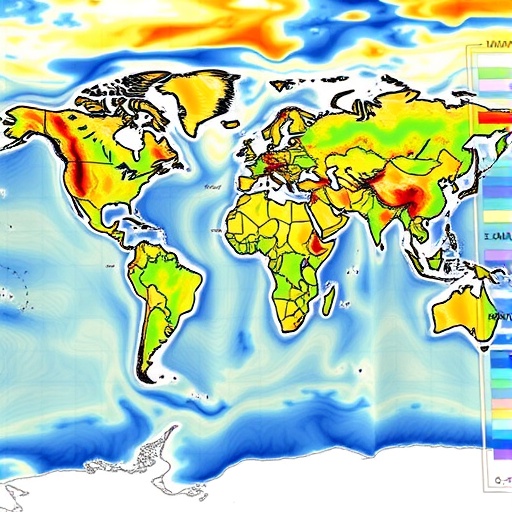In a groundbreaking study recently published in Nature Communications, researchers have unveiled the global patterns and drivers of nitrogen isotope signals in modern marine sediments, offering profound insights into the biogeochemical cycles that govern our oceans. Nitrogen isotopes act as crucial tracers for understanding marine nutrient dynamics, but until now, a comprehensive global synthesis of these signals in sedimentary records has been lacking. This work fills that crucial gap, providing an unprecedented synthesis that redefines how scientists interpret the nitrogen cycle in both contemporary and paleoceanographic contexts.
Nitrogen is fundamental to marine ecosystems, constituting an essential nutrient that regulates productivity and influences carbon cycling. Its isotopic composition, specifically the ratio between the heavy isotope ^15N and the lighter ^14N (^15N/^14N), captured in marine sediments, serves as a sensitive proxy for past and present biogeochemical processes. However, interpreting these nitrogen isotope signals has been challenging due to complex interactions among microbial processes, ocean circulation, and external nutrient inputs. The research team, led by Sun, Fan, and Hu, addressed these challenges by integrating a vast dataset of nitrogen isotope measurements from diverse sediment samples collected worldwide.
Their study compiled and analyzed nitrogen isotope data from over a thousand locations, spanning multiple ocean basins and various depositional environments. This expansive approach allowed the team to identify clear global-scale patterns, revealing that nitrogen isotopic signals are not homogenous but instead reflect regional biogeochemical drivers and oceanographic settings. The findings highlight distinct isotopic signatures associated with major oceanographic features like upwelling zones, oxygen minimum zones (OMZs), and variations in nutrient supply and utilization.
One of the key revelations is the strong influence of oxygen minimum zones on the nitrogen isotope record. OMZs, which are regions in the ocean characterized by critically low oxygen concentrations, facilitate specific microbial pathways such as denitrification and anammox, which preferentially consume lighter nitrogen isotopes, thus enriching sedimentary nitrogen in ^15N. The study quantifies this effect on a global scale and demonstrates how expanding OMZs, driven by climate change and ocean deoxygenation, could significantly alter the marine nitrogen isotope signal.
The role of nitrogen fixation processes was also considered integral to explaining variations in isotopic compositions. Nitrogen fixation introduces isotopically lighter nitrogen into the marine environment, counterbalancing the heavy ^15N enrichment caused by denitrification. By incorporating data on nitrogen-fixing organisms and their biogeographical distribution, the researchers linked isotope patterns to dynamic feedbacks between nitrogen inputs and the redox state of marine waters.
In addition to biological factors, physical processes such as ocean circulation exert strong control over nitrogen isotope distributions. The team used oceanographic data to correlate isotope variations with currents, mixing rates, and sedimentation patterns. For example, in regions influenced by strong upwelling, nutrient-rich, isotopically distinct waters can alter sediment isotopic values, reflecting a complex interplay between physical transport and biological cycling.
The study employed advanced isotopic modeling tools to disentangle the overlapping signals recorded in sediments. By coupling isotope fractionation models with sedimentation and microbial community data, the authors could reconstruct underlying processes with greater precision. Their interdisciplinary approach, combining geochemical measurements, microbial ecology, and ocean physics, embodies the next frontier in marine biogeochemistry research.
Significantly, the work provides an essential reference frame for interpreting past marine nitrogen cycle dynamics derived from sediment cores. Paleoceanographers can now use this global isotopic synthesis to better contextualize shifts in nitrogen cycling during key geological intervals, such as glacial-interglacial transitions or periods of ocean anoxia. This enhanced interpretive power holds promise for reconstructing past ocean productivity, nutrient availability, and oxygenation history with improved accuracy.
This research also highlights the sensitivity of the marine nitrogen cycle to ongoing environmental changes. As human activities and climate change continue to alter oceanic oxygen levels, nutrient distributions, and microbial communities, nitrogen isotope signals in sediments will respond accordingly. The study’s findings underscore the potential of nitrogen isotopes as effective biomarkers for monitoring marine ecosystem health and biogeochemical responses to anthropogenic perturbations.
Moreover, the team’s work offers valuable insights for improving global biogeochemical models that predict ocean nutrient cycling and feedbacks to climate systems. Incorporating accurate nitrogen isotope data into these models can refine simulations of marine productivity and carbon sequestration, enhancing predictions of future climate scenarios. Such improvements are crucial for informed policy decisions addressing climate change mitigation and marine resource management.
The global nature of this investigation also serves as a call for expanded international collaboration and data sharing. By creating a comprehensive nitrogen isotope database, the authors emphasize the importance of broad, integrative approaches to unraveling the complex interdependencies in Earth’s ocean systems. Future research will benefit from ongoing sediment sampling campaigns, enhanced isotopic analytical techniques, and greater incorporation of molecular biology methods.
In conclusion, this seminal study pushes forward our understanding of marine nitrogen cycling through a meticulous global survey and innovative analytical framework. By revealing the spatial variability and driving factors behind nitrogen isotopic signals in marine sediments, Sun, Fan, Hu, and colleagues provide a vital tool for both contemporary oceanography and paleoenvironmental reconstructions. Their work exemplifies how integrated, interdisciplinary research can unlock new perspectives on fundamental Earth system processes, with far-reaching implications for climate science, marine ecology, and environmental stewardship.
Subject of Research: Global patterns and controlling factors of nitrogen isotope signals in modern marine sediments and their implications for marine biogeochemical cycles and paleoceanographic studies.
Article Title: Global patterns and drivers of nitrogen isotope signal in modern marine sediments
Article References:
Sun, X., Fan, D., Hu, L. et al. Global patterns and drivers of nitrogen isotope signal in modern marine sediments. Nat Commun (2025). https://doi.org/10.1038/s41467-025-66439-8
Image Credits: AI Generated




